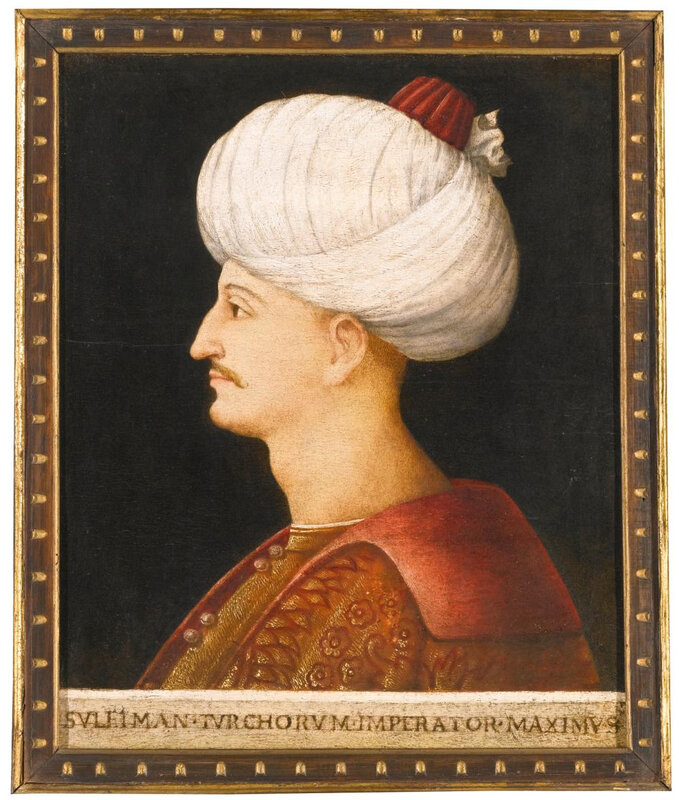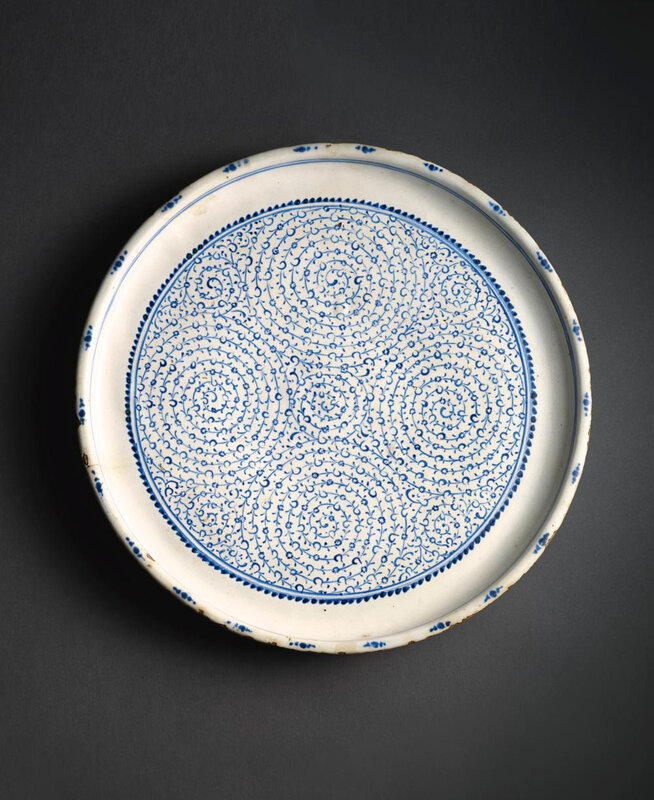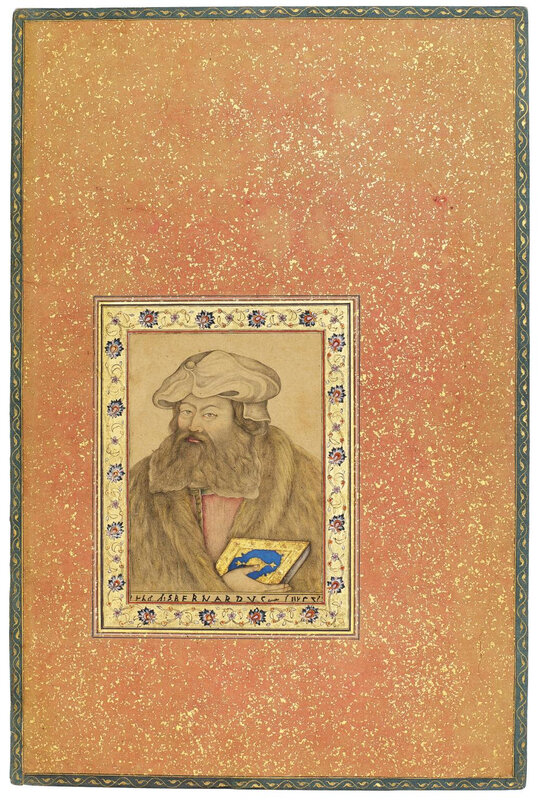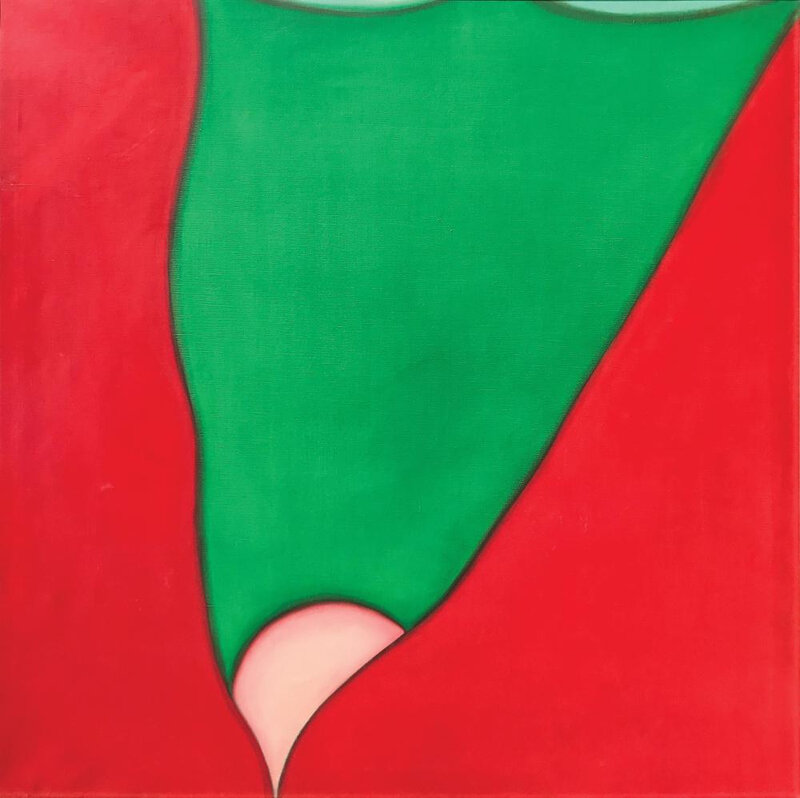Middle Eastern Art Week led by £5.4 million portrait of Suleyman the Magnificent & 12 artist records

Lot 129. Property of a Royal Collection. A portrait of Suleyman the Magnificent, by a follower of Gentile Bellini, Italy, probably Venice, circa 1520; oil on panel, framed; painting: 32.5 by 28cm. frame: 42 by 36cm. Estimate 250,000 — 350,000 GBP (290,200 - 406,280 EUR). Lot sold 5,323,500 GBP (6,172,085 EUR). Courtesy Sotheby's.
LONDON.- The Arts of the Islamic World sale, which explores over 1,200 years of creativity and craftsmanship across several continents, brought a total of £9,914,625 / $12,951,475 (est. £4.2-6.1 million). One of the few Western images of an Eastern potentate by a European artist, this striking portrait of a young Suleyman the Magnificent (circa 1520) sparked a lengthy three-way bidding battle today, which saw it surpass its estimate of £350,000 – 500,000 by eighteen times to sell for £5,323,500 / $7,035,005. Testament to its rarity, Suleyman does not seem to have commissioned any portraits, and so details of his appearance were conveyed through sketches by those who had accompanied foreign embassies to the Ottoman court, and so it is very likely that either Andrea Gritti or his son Alvise Gritti were the patrons behind this portrait.
Edward Gibbs, Sotheby’s Middle East & India Chairman, said: “There has been a real buzz in our exhibitions over the past week, and this sense of excitement has carried through into the saleroom – with enthusiastic bidding from private collectors and institutions alike. One snapshot into this was the fervour and determination with which three bidders – including one joining us from online – battled it out for the Venetian portrait of fabled Ottoman Sultan Suleyman the Great, an artwork that perfectly encapsulates the desired elements of rarity, provenance and beauty, as well as the notion of creative synergy between different cultures that is so inherent in our category. There was a real breadth to the offering, which was reflected by the depth of bidding, and the range of records set for artists across The sale also featured fine rugs and carpets, led by an inscribed and dated intensely golden Persian silk rug – made for Fath-‘ali Shah, the second Qajar emperor of Iran – which doubled its estimate to make £150,000. the region and beyond was for both established, institutional, and indeed treasured, artists alongside names that we were introducing to our collectors for the first time. It is wonderful to witness, and to play a role in, an ever-increasing audience discovering the truly global appeal of this area of the market.”
Cf; my post: A portrait of Suleyman the Magnificent, by a follower of Gentile Bellini, Italy, probably Venice, circa 1520
A further highlight of the auction was a rare intact Iznik ‘Golden Horn’ pottery dish, circa 1530, one of the last remaining examples of the unusual style which took its inspiration from contemporary illumination. Returning to the same saleroom it was last offered in 1986, the important piece made £531,000 / $701,717.

Lot 130. A rare and important Iznik 'Golden Horn' pottery dish, Turkey, circa 1530; 28.2cm. diam. Estimate 300,000 — 500,000 GBP (348,240 - 580,399 EUR). Lot sold 531,000 GBP (615,643 EUR). Courtesy Sotheby's.
Cf. my post: A rare and important Iznik 'Golden Horn' pottery dish, Turkey, circa 1530
A number of exquisite examples of Indian miniature painting were met with demand across the auction. A remarkable early 17th century Mughal version of a 1524 engraving by Dürer of the powerful ruler Frederick the Wise, Elector of Saxony, sold for five times its estimate at £102,500 / $135,454, and a previously unknown illustration of a battle raging outside a walled fortress, attributed to royal artist Sur Das doubled its estimate at £143,750. The selection of precious Indian jewellery in the sale was led by an important imperial gem-set and enamelled turban ornament (sarpech), from the family of Hari Singh Nalwa, which made a double-estimate £350,000 / $462,525.


Lot 86. A drawing of Frederick the Wise, Elector of Saxony (1463-1525), after a 1524 engraving by Albrecht Durer, India, Mughal, first half 17th century, the reverse with a page of calligraphy by Mir 'Ali, Herat or Bukhara, circa 1500-35, drawing: 11.6 by 8.5cm, leaf: 39 by 22.5cm. Estimate 15,000 — 25,000 GBP (17,391 - 28,985 EUR). Lot sold 102,500 GBP (118,839 EUR). Courtesy Sotheby's.
drawing on paper with use of colours and gold, inner borders of floral motifs in colours on gold, wide outer border of gold-flecked orange paper, inscribed below in a crude hand imitating Latin “S. Bernardus”; reverse with a central panel containing four diagonal lines of Persian poetry in nasta‘liq script signed by Mir 'Ali, inner calligraphic border, wide outer border of gold-flecked orange paper.
Provenance: Sotheby’s London, 4 April 1978, lot 221.
Note: This striking image of a heavily bearded European man wearing a hat and a fur coat is a Mughal version of a 1524 engraving by Albrecht Durer (1471-1528) of Frederick the Wise, Elector of Saxony (1463-1525).

Albrecht Dürer, Frederick the Wise, Elector of Saxony, 1524, Engraving, 19.4 x 12.8 cm, The Art Institute of Chicago, Chicago, US.
European engravings arrived in India from the late sixteenth century onwards, brought by missionaries, travellers, diplomats and merchants. The imagery they contained was taken up by artists during the reigns of Akbar and Jahangir, and Mughal versions of European prints, some copied verbatim, some with variations or adapted, had become a major feature of Mughal art. The majority of the subjects were religious, including Biblical figures, Christian scenes and figures of saints, or were taken from classical mythology – reflecting the sort of engravings that were brought to India. The copying of a near-contemporary secular figure such as the present example was altogether rarer (another secular example, an equestrian portrait of the Earl of Nottingham, the Lord High Admiral during the reigns of Elizabeth I and James I based on an engraving by the English printmaker Thomas Cockson of 1596-1603, is in the Fitzwilliam Museum, Cambridge, see M. Fraser, From Kabul to Kolkata, Highlights of Indian Painting in the Fitzwilliam Museum, Cambridge, 2017, no.25, pp.62-63).
The Mughal artist of the present work has kept quite closely to the original – the face, hat, shape of the beard and the thick fur coat are all quite accurate. The two major differences introduced by the Mughal artist are the book held in the right hand and the fact that the figure’s eyes are looking towards the viewer, whereas in Durer’s print they are gazing off to the left. The texture of the beard has also changed subtly, although the general shape and bushiness remains the same. The book held in the right hand is an interesting addition, as it implies that the artist had seen an engraving of a similar figure holding a book. A strong candidate is a 1587 engraving by Christoph Murer of the French-Swiss religious reformer Wolfgang Musculus (d.1563), who bore a resemblance to Frederick the Wise (at least in the engravings) and had a similarly bushy beard (examples of the engraving are in the Staatliche Graphische Sammlung, Munich and the University of Tubingen Library). The head and shoulders image shows Musculus in a similar pose to Frederick, wearing a similar hat and fur-lined coat, but significantly he is holding a book. Alternatively, the presence of the book here may be linked to the inscription below the drawing that mentions Saint Bernard. The inscription may have been copied from an engraving of St. Bernard, but, being unfamiliar with the Latin script, the artist has made some mistakes in the lettering. Engravings of at least three Saints Bernard (Bernard of Clairvaux (d.1153), Bernard of Uberti (d.1133) and Bernardino of Siena (d.1444)) were in circulation in Europe by the late sixteenth century and although the figures themselves do not resemble Frederick the Wise, most of the engravings show these saints holding a book. One or more of these images of the saints and/or Musculus may have found their way to India and been combined by the Mughal artist with Durer’s image of Frederick the Wise. It is also possible that the drawing was influenced by earlier Mughal versions of these amalgamated European images. A good candidate for an earlier Mughal model is a full-length figure of a European with an extremely similar face, hat and fur coat holding a book in his hand, dating to circa 1595. It was formerly in the Khosrovani-Diba Collection, sold in these rooms 19 October 2016, lot 11.
The calligraphy on the reverse consists of nasta'liq verses by the Persian poet Mir 'Ali, copied by the great early sixteenth century master of nasta‘liq Mir 'Ali, whose works were greatly sought after in Mughal India and were included in large numbers in the royal albums of the first half of the seventeenth century.
Frederick the Wise, Elector of Saxony (1463-1525) was one of Durer's earliest patrons and commissions by him helped Durer’s reputation and influenced others to patronise the artist. The print of Frederick the Wise was based on a drawing by Durer now in the Ecole des Beaux-Arts, Paris. Frederick the Wise was a powerful Catholic ruler, but towards the end of his life he transferred his allegiance to the Lutheran cause. Following Luther's excommunication in 1521 Frederick ensured his safe protection in Wartburg Castle, and is thus remembered as the man who saved Martin Luther from the wrath of the Catholic Church (see http://collections.vam.ac.uk/item/O137565/frederick-the-wise-elector-of-print-durer-albrecht/).
Sotheby’s is grateful to Marcus Fraser for cataloguing this lot.
Lot 85. Probably a previously unknown illustration from the ‘British Library/Chester Beatty’ Akbarnama: a battle outside a walled fortress, attributed to Sur Das, India, Mughal, circa 1602-03, coloured drawing with gold on paper, borders of gold-flecked orange paper; painting: 17 by 12.8cm, leaf: 40.4 by 28.8cm. Estimate 120,000 — 180,000 GBP (139,296 - 208,944 EUR). Lot sold 350,000 GBP (405,791 EUR)
Provenance: From an album assembled by Colonel John MacGregor Murray, Bart (1745-1822), Bengal and Scotland.
Sotheby’s London, 15 June 1959, lot 117.
Sotheby’s London, 21 April 1980, lot 128.
Colnaghi Oriental, London, 1984.
John MacGregor Murray, who acquired this painting along with several others in the late eighteenth century, was commissioned in to the Bengal Establishment of the East India Company in 1771, rising to the rank of Colonel in 1787. He was an influential and respected military administrator and among the appointments he held was the post of Military Auditor-General. He was also vice-president of the Asiatic Society of Bengal. In 1795 he was awarded a baronetcy and retired to Scotland in 1798, where he became Deputy Lord Lieutenant of Perthshire (see The East India Military Calendar, Containing the Services of General and Field Officers of the Indian Army, London, 1824, pp.461-3). The album of paintings he assembled in India was sold at auction in these rooms, 15 June 1959, lot 117, acquired by Hagop Kevorkian and subsequently dispersed. This leaf was sold again at Sotheby’s, 21 April 1980, lot 128.
Exhibited: Museum of Fine Arts, Houston, 2004.
Indeed, it may be a previously unknown illustration from the Second Akbarnama. Stylistically the drawing accords with a number of other illustrations from the manuscript, which included drawings and nim-qalam as well as fully coloured miniatures. For a full account of the manuscripts and surviving folios see L. Leach, Mughal and other Indian Paintings from the Chester Beatty Library, Dublin, 1995; Losty and Roy, Mughal India, Art, Culture, empire, pp.58-70). Although the majority of folios are preserved in the British Library (163 folios with 39 illustrations, all from part 1), and Chester Beatty Library, Dublin (268 folios with 61 illustrations, from parts 2 and 3, plus seven further illustrations separately mounted), a number are dispersed in other institutions and private collections, including the Freer Gallery of Art, Washington D.C. (see Beach, The Imperial Image, Washington, 2012, nos.10A-E); the Cleveland Museum of Art (see S. Quintanilla et al., Mughal Painting Art and Stories, Cleveland and London, 2016, fig.4.39, p.171); the Walters Art Gallery, Baltimore, and the Cincinnati Museum of Art. Several have appeared in the market over the last few decades, at least two previously unknown: Sotheby's London, 24 October 2018, lots 75 and 90, 24 October 2007, lot 34; 6 December 1967, lot 124, 13 July 1971, lots 127-8; Sotheby's New York, 25 March 1987, lots 183-6, 2 November 1988, lot 102; Christie's London, 26 October 2017, lot 183; 25 April 1995, lots 8,8A; P and D Colnaghi, London, Persian and Mughal Art, 1976, nos.86i, ii, iii.
The present drawing corresponds closely in size to others from the manuscript: it currently measures 17 by 12.8cm, but has probably been trimmed somewhat at the lower edge and upper edges and possibly at the lateral edges when it was mounted into the later album borders. Thus its original size was probably closer to 21 by 14 cm, which is within the size range of surviving illustrations. It has not yet been possible to identify the specific battle scene depicted here, but further research may bear fruit.
The miniature was given a verbal attribution by Robert Skelton to the artist Sur Das. This attribution would further support the likelihood that the miniature originates from the Second Akbarnama, as Sur Das was one of the most prolific royal artists of the period and painted at least thirteen miniatures in the Second Akbarnama as well as many in other royal manuscripts of the late sixteenth and early seventeenth century. For further information on Sur Das see the entry on Sur Das in S. Verma, Mughal Painters and Their Works, Delhi, 1994, see also L. Leach, Mughal and other Indian Paintings from the Chester Beatty Library, Dublin, 1995, vol.II, pp.1117-18.
The Second Akbarnama manuscript is usually dated to 1602-03 based on two small inscriptions giving regnal year dates of Akbar’s reign. One appears on a folio in the British Library and the other on a folio in the Chester Beatty Library. There has been considerable discussion as to how to read these dates, and as well as the generally accepted 1602-03, a reading that gave a date of 1597-98 was proposed by Seyller in 1987. This latter dating was refuted by Leach in 1995 and recent publications have kept to the dating of 1602-03. For a detailed analysis and discussion of the manuscript see Leach 1995, vol.1, pp.232-294, particularly p.240 for the discussion of the dating; see also J. Seyller, 'Scribal Notes on Mughal Manuscript Illustrations', Artibus Asiae, 48, 1987, pp.261-2. 275; for a more recent discussion see J. Losty and M. Roy, Mughal India, Art, Culture, Empire, 2012, pp.58-69.
Sotheby’s is grateful to Marcus Fraser for cataloguing this lot.

Lot 171. An important imperial gem-set and enamelled turban ornament (sarpech), India, probably Deccan, 19th century, from the family of Hari Singh Nalwa. Estimate 120,000 — 180,000 GBP (139,296 - 208,944 EUR). Lot sold 350,000 GBP (405,791 EUR). Courtesy Sotheby's.
Cf. my post: An important gem-set and enamelled turban ornament (sarpech), India, probably Deccan, 19th century
The sale also featured fine rugs and carpets, led by an inscribed and dated intensely golden Persian silk rug – made for Fath-‘ali Shah, the second Qajar emperor of Iran – which doubled its estimate to make £150,000.

Lot 297. A West Persian silk rug with an inscription panel, the inscription reading: hasb al-amr-e navvab-e mustatab-e ashraf-e vala na’ib al-saltanah ‘By the order of the Highness, the Gracious, the Noble, the Exalted, the Vice-regent (Na’ib al-Saltanah)' ‘amal-e nawruz saruqi fi 1205 ‘The work of Nawruz Saruqi in 1205 (1790-91)’, approximately 295 by 197 cm.,9ft. 8in; 6ft. 5in., dated AH 1205 (1790-91 AD). Estimate 60,000 — 80,000 GBP. Lot sold 150,000 GBP (173,911 EUR). Courtesy Sotheby's.
20TH CENTURY ART / MIDDLE EAST (30 APRIL 2019)
A vibrant international platform for Middle Eastern Modern and Contemporary art, yesterday’s auction soared beyond expectations to bring £3,458,000 / $4,473,615 (est. £2.1-2.9 million) – with 91% of the lots finding a buyer, and over half of these surpassing their high estimates. The result stands as the second-highest total achieved since the reintroduction of the sale in London in 2015. The auction was led by Iraqi Modernist Mahmoud Sabri’s rare, monumental masterpiece The Death of a Child (1963) sold for a double-estimate £891,000 / $1,152,687. Appearing on the market for the first time since it was acquired directly from the artist in the 1980s, this bold, poignant work set a new auction record for the celebrated artist.

Lot 31. Mahmoud Sabri (Iraqi, 1927 - 2012), Al Mawt al-Tafl (The Death of a Child), signed M.S. and dated 1963 in Arabic, oil on canvas, 137 by 196cm.; 54 by 77 1/8 in. Estimate 350,000 — 500,000 GBP. Lot sold 891,000 GBP (1,031,063 EUR). Courtesy Sotheby's.
A further highlight was a record for Huguette Caland, one of Lebanon’s most influential female icons whose first UK museum show is set to open at the Tate St Ives later this month. A rich crimson and emerald work on the female form, lovingly painted in 1973, sold for £187,500 / $242,569. Continuing the celebration of Lebanese female artists, a record was also achieved for beloved painter and poet Etel Adnan. Brimming with energy, a dazzling canvas from the 1960s, reminiscent of the landscapes from which she drew her inspiration, made its auction debut at £131,250 / $171,137, more than triple its estimate.

Lot 16. Huguette Caland (Lebanese, B. 1931), Untitled, signed and dated H. Caland 1973 on the reverse, oil on canvas, 120 by 120cm.; 47 1/4 by 47 1/4 in. Estimate 120,000 — 180,000 GBP. Lot sold 187,500 GBP (216,974 EUR). Courtesy Sotheby's.
Elsewhere in the sale, records tumbled for artists from the across the region, including Iranian architect Siah Armajani, whose first major US retrospective opened at The Met Breuer in February, Emirati pioneer Hassan Sharif, Saudi artist Mohammed Al Saleem, self-taught Lebanese artist Willy Aractingi and photographer to the stars Firooz Zahedi. There were a number of benchmark prices achieved for artists making their debut at auction, including Emirati conceptual artist Mohammed Ahmed Ibrahim, Saudi artists Nabila Al Bassam, Abdullah Al Marzook and GCC, Egyptian surrealist Mamdouh Ammar, Kuwaiti artist Thuraya Al-Baqsami and Palestinian painters Abed Abdi and Samira Badran.
The day also saw strong prices for rare works by ‘blue chip’ names Mahmoud Mokhtar and Bahman Mohasses. A rare and important bronze by Egypt’s most significant sculptor, gifted to his teacher Jules-Félix Coutan in the 1930s, Three Beggars (circa 1929-30), sold for £150,000 / 194,055. Elmo Antico (1969), an intellectual insight into both the artist’s love for ancient civilisations and the grotesque malformation he saw in humankind, sold for £150,000 / $194,055.

Lot 30. Mahmoud Mokhtar (Egyptian, 1891-1934), The Three Beggars, signed M. Mouktar and inscribed FONDERIE DES ARTISTES PARIS, bronze, 34 by 33.5 by 17cm.; 13 3/8 by 13 1/8 by 6 5/8 in. Executed circa 1929-1930, the edition number of this work is unknown. Only two other editions are known to Sotheby's, the other edition is in the Mokhtar Museum in Cairo. Estimate 80,000 — 120,000 GBP. Lot sold 150,000 GBP (173,580 EUR). Courtesy Sotheby's.

Lot 48. Bahman Mohasses (Iranian, 1931-2010), Elmo Antico (Ancient Helmet), signed and dated B. Mohasses '69; signed, titled and dated on the reverse, oil on board, 100 by 70cm.; 39 1/3 by 27 1/2 in. Estimate 100,000 — 150,000 GBP. Lot sold 150,000 GBP (173,580 EUR). Courtesy Sotheby's.
THE ORIENTALIST SALE (30 APRIL 2019)
Now in its eighth season, The Orientalist Sale brought a total of £5,367,500 / $6,943,935 (est. £5-7.3 million / $6.5-9.4 million) and was led by Jean-Léon Gérôme’s rare masterpiece, Rider and His Steed in the Desert. The painting, which last changed hands when it was sold by the Fine Art Society in 1980, achieved £1,155,000 / $1,494,224. One of Gérôme’s most famous compositions, Evening Prayer, Cairo commanded the second highest price when it sold for £735,000 / $950,870.

Lot 26. Jean-Léon Gérôme (French, 1824-1904), Rider and his Steed in the Desert, 1872, signed J.L.GÉRÔME lower right, oil on canvas, 60 by 101cm. Estimate £1,000,000-1,500,000. Lot sold 1,155,000 GBP (1,336,563 EUR). Courtesy Sotheby's.

Lot 22. Jean-Léon Gérôme (French, 1824-1904), Evening Prayer, Cairo, signed J.L. GEROME lower left, oil on panel, 49.5 by 81cm. Estimate £600,000-800,000. Lot sold 735,000 GBP (850,540 EUR). Courtesy Sotheby's.
The sale opened with a superb and rare group of watercolours by David Roberts, which had remained in the same distinguished private collection since they were acquired in the 1970s and 1980s. Together, the 13 works brought a total of £560,625 / $725,281, exceeding the pre-sale high estimate for the group (£350,000-533,000 / 452,795-689,542).
Four new artist records were set, for Auguste Veillon (Halt in the Desert, sold for £312,500 /$404,281); Carl Haag (The Holy Rock, Jerusalem, sold for £275,000 / $355,768); Carl Saltzmann (Leander's Tower and the Old City Beyond, Constantinople, sold for £275,000 / $355,768), and Enrico Tarenghi (The Entertainers, sold for £118,750 / $153,627).

Lot 54. Auguste Veillon (Swiss, 1834 - 1890), Halt in the Desert, signed A. Veillon lower left, oil on canvas, 116 by 193cm., 45½ by 76in. Estimate £80,000-120,000. Lot sold 312,500 GBP (361,624 EUR). Courtesy Sotheby's.
Provenance: Selano Gallery (by 2000)
Sale: Dobiaschofsky, Bern, 8 November 2002, lot 1037
Purchased at the above sale by the present owner.
Note: This evocative, panoramic view captures a camel caravan in a desert landscape, very possibly the Sinai close to the shores of the Red Sea, halting for water. With great mastery, Veillon evokes the stillness of the desert air as the journeymen encounter a local water carrier at a well. Although they rarely travelled faster than the walking speed of a man, camels' ability to handle harsh conditions and long distances without drinking made them ideal for communication and trade in the desert areas of northern Africa and the Arabian peninsula for centuries.
Veillon studied under François Diday in Geneva before enrolling at the Ecole des Beaux-Arts in Paris in 1858. While in Paris, he spent a considerable amount of time in the Louvre, copying the works of the masters, especially the seventeenth-century Dutch masters and the work of Claude Lorrain, whom he later credited for the luminism that defines his landscapes. Veillon's neighbour in the French capital was the Orientalist painter Eugène Fromentin, who sparked his interest in Orientalist themes and inspired him to see the Middle East for himself. He went on to visit Egypt at least four times, in 1873 staying there with his friend, the artist Etienne Duval (1824-1919).

Lot 19. Carl Haag (German, 1820 - 1915), The Holy Rock, Jerusalem, inscribed, signed and dated The Holy Rock. Jerusalem. Original Study finished on the Spot, by Carl Haag. June 1859. lower left, watercolour over pencil on paper, 36 by 52cm., 14 by 20½in. Estimate £50,000-70,000. Lot sold 275,000 GBP (318,229 EUR). Courtesy Sotheby's.

Lot 59. Carl Saltzmann (German, 1847 - 1923), Leander's Tower and the Old City Beyond, Constantinople, signed and inscribed C. Saltzmann Nbbg lower left, oil on canvas, 126 by 250.5cm., 49.5 by 98.5in. Estimate £100,000-150,000. Lot sold 275,000 GBP (318,229 EUR). Courtesy Sotheby's.
Cf. my post: Rare masterpiece by Jean-Léon Gérôme leads Sotheby's annual Orientalist Sale

Lot 77. Enrico Tarenghi (Italian, 1848 - 1938), The Entertainers, signed and dated E. tarenghi / Roma 1897 lower right, watercolour over pencil on paper, 122 by 74.5cm., 48 by 29¼in. Estimate £15,000-20,000. Lot sold 118,750 GBP (137,417 EUR). Courtesy Sotheby's.

/https%3A%2F%2Fprofilepics.canalblog.com%2Fprofilepics%2F1%2F0%2F100183.jpg)
/https%3A%2F%2Fstorage.canalblog.com%2F03%2F02%2F119589%2F96711876_o.jpg)
/https%3A%2F%2Fstorage.canalblog.com%2F11%2F31%2F119589%2F94773502_o.jpg)
/https%3A%2F%2Fstorage.canalblog.com%2F20%2F83%2F119589%2F94772815_o.jpg)
/https%3A%2F%2Fstorage.canalblog.com%2F26%2F72%2F119589%2F75604929_o.jpg)
/https%3A%2F%2Fstorage.canalblog.com%2F59%2F60%2F119589%2F26458628_o.jpg)


/http%3A%2F%2Fstorage.canalblog.com%2F06%2F39%2F119589%2F129007933_o.jpg)
/http%3A%2F%2Fstorage.canalblog.com%2F83%2F41%2F119589%2F128989180_o.jpg)
/http%3A%2F%2Fstorage.canalblog.com%2F65%2F49%2F119589%2F128551133_o.jpg)
/http%3A%2F%2Fstorage.canalblog.com%2F11%2F78%2F119589%2F126903004_o.jpg)